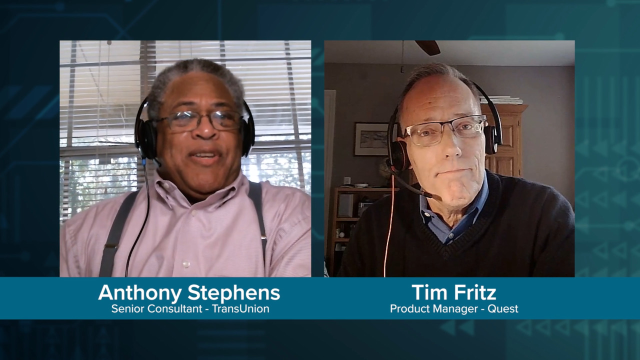Good afternoon, good evening to everyone. With regards to my role at TransUnion, I see myself as an IT professional. I play an important role in making trust possible through technology as a senior consultant and a site reliability engineer. I support SQL Server business critical applications, and part of my responsibilities includes collaborating with a diverse team of application and infrastructure colleagues to deliver new, reliable, and stable feature rich solutions to market, as we here at TransUnion are constantly engaged in new innovative ways to connect and empower businesses and consumers.
And I also have a responsibility and a focus on maintaining high levels of uptime and optimal performance for these business critical applications. We constantly are looking to deliver results to our clients with speed and accuracy, as I'm sure-- I'm glad to say that Foglight nicely enhances our ability to achieve this objective.
Let me just say, we've been using Foglight for well over seven years here at TransUnion, and we actually started off with the Quest Spotlight product and then transitioned into Foglight. For a good number of years we were just using Foglight here in the US, but in recent years we've actually expanded that.
We're now using Foglight in all of our regions which consists of Canada and Hong Kong, India, Latin America, the Philippines, South Africa, and the UK. We're focusing in the US on SQL Server and Postgres database monitoring. In some of our other regions, Tim, we're actually using Foglight to monitor and manage DB2 as well as MySQL.
So Foglight gives us quick insights, and we'll talk a little bit more about that as we go along. But it's being able to quickly gain insights into what's going on within our SQL Server. Ideally, we want to be proactive, and we'll dive a little deeper into that adaptive baseline feature that Foglight provides us with so that we can be proactive and preventing problems.
And then also being able to have a quick reaction response posture when problems do surface, when performance becomes less than optimal. And we definitely lean very heavily on Foglight. It's our tool of choice, if you will, that we go to when we need to gain understanding as to why there's pain in the application space or the database space.
And Foglight helps us to understand where that pain is in terms of queries that might not be running as optimally as they previously were, for whatever reasons. It could be blocking, it could be locks that are occurring. Shifted data, our data has grown and so we may not have the right index or we may not have the right query plan that we previously had in place, the most optimal query plan. So Foglight helps us to understand that. Gives us, again, quick insight so we can identify what's going on and then take whatever remediation action is necessary to get out of the pain.
But it's really nice to be able to have a product that puts all of the necessary components, dashboards if you will, in one place. So it's a one place stop that we can go to gain insights, various types of insights. Foglight provides this Heatmap dashboard, which is really a cool, very cool feature. But we use that so we can actually identify which particular instances of SQL Server may have more elevated alarms and in need of attention versus others that are not running hot in terms of various alarms that indicates that we may have exceeded a particular baseline of normal behavior.
One of the powerful features that Foglight brings to help enhance our ability to be more effective in maintaining optimal performance is the Performance Investigator. That is a very cool feature where we can actually look at what's going on at the query level. We can look at it real time as queries are being executed. Or we can go back in time and look at what was happening at a particular point where one of our application resources may say, hey, we had a hiccup, can you investigate and help us understand what happened at that point in time? So that Performance Investigator is very cool. It's very important to us.
Foglight gives us the ability to dive into that very quickly, with these waits analysis. And Tim, the dimensions or the filtering is really cool. So we use this so that we can surgically dive into a particular area where the pain is most noticeable or there's going to potentially be pain if we don't take action.
When I think of Foglight, I really think of a feature rich product in the industry that really offers some essential supportive capabilities. It really aids us and enhances-- I think that's the key piece there. It enhances our ability, as I've mentioned a couple of times, just to gain quick insights into database performance and to understand with ease and minimum effort.
So on the closing note, if I may, I believe the change in your partnership with Quest and the use of the Foglight product helps us to achieve one of our key objectives. And that's to make trust possible through technology. And at the end of the day, it helps us to deliver information for good to our valuable businesses and our customers.
 06:48
06:48
